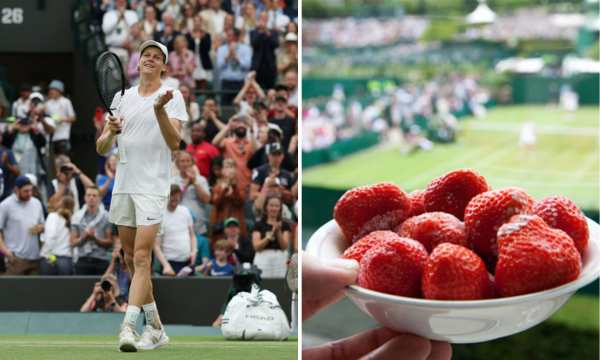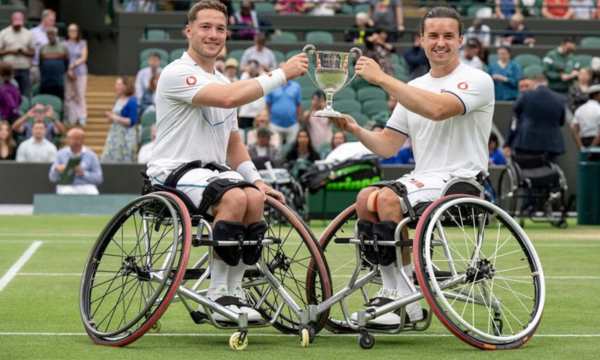Wimbledon: The Most Traditional Tennis Tournament
Wimbledon is a tennis tournament that combines century-old tradition and sporting excellence in one place.
Anúncios
Every aspect of this Grand Slam preserves rituals that withstand the test of time, from the strict white dress code to the serving of strawberries and cream.
The British royalty, Victorian architecture, and meticulously maintained gardens form the backdrop where the world’s greatest tennis players write their names in history.
Join us on this journey through the most prestigious tournament on the tennis calendar.
How Wimbledon Became the Pioneer of Tennis
The Wimbledon tournament was born in 1877 when the All England Croquet Club decided to include lawn tennis in its activities.
The first men’s competition attracted only 22 players and about 200 spectators. The codified rules for this occasion laid the foundations of modern tennis as we know it today.
Women were only included in 1884, seven years after the first men’s edition. The competition has always remained steadfast in preserving its traditions while embracing necessary innovations.
The first televised tournament took place in 1937, significantly expanding its global popularity.
Wimbledon is the oldest tennis tournament in the world and the only Grand Slam still played on natural grass.
This unique surface has shaped not only the style of play but also the elegance and tradition that are synonymous with the tournament to this day.
The Untouchable Traditions of SW19
In Wimbledon, postal code SW19, time seems to move at a different pace, where certain traditions remain absolutely untouchable. The iconic white dress code is perhaps the most well-known of them.
The British royalty maintains a constant presence at the tournament, with members of the royal family frequently occupying the Royal Box on the center court.
The protocol requires players to bow when entering the court when the royal family is present.
The connection between the tournament and the British monarchy dates back to its earliest editions.
The ball boys and girls undergo rigorous six-month training to meet the standard of excellence required.
Selected from local schools, they follow a code of conduct that includes never touching their face during the game and remaining absolutely still during points.
Traditions that define Wimbledon:
- Strawberries and cream (28 tons consumed per tournament).
- Absence of advertising on the main courts.
- Middle Sunday (traditionally a rest day, modified only in 2022).
- Organized queues for day tickets (The Queue).
- The hierarchy system is another traditional aspect, where previous champions are treated with special deference.

Traditions-at-Wimbledon-(Source-Google)
Trophies and Legacies: The Greatest Champions in Tournament History
The golden trophy for men and the silver Rosewater dish for women represent two of the most coveted trophies in the world of sports.
The name of each champion is carefully engraved on these historical treasures, creating a permanent record of tennis excellence through the generations.
Roger Federer established himself as the greatest male champion in the modern era with eight titles. His on-court elegance seemed perfectly aligned with the spirit of the tournament.
Martina Navratilova dominated the women’s scene with nine individual titles, a record that remains unbeaten to this day.
Greatest Wimbledon champions:
Men (Open Era):
- Roger Federer: 8 titles
- Novak Djokovic: 7 titles
- Pete Sampras: 7 titles
- Björn Borg: 5 consecutive titles
Women (Open Era):
- Martina Navratilova: 9 titles
- Steffi Graf: 7 titles
- Serena Williams: 7 titles
- Venus Williams: 5 titles
Stories of triumph at the British tournament often transcend the sport.
Unforgettable Moments of Wimbledon
The 2008 men’s final between Roger Federer and Rafael Nadal is often considered the greatest match in tennis history.
For nearly five hours, including two rain interruptions, the two titans dueled until Nadal finally prevailed in the growing twilight, ending Federer’s dominance after five consecutive titles.
In 1980, another epic match in the tournament entered history when Björn Borg defeated John McEnroe after a legendary tiebreak in the fourth set, which ended 18-16.
Other memorable moments on the courts:
- Boris Becker’s victory at age 17 in 1985.
- The epic 70-68 tiebreak between Isner and Mahut in 2010.
- Andy Murray’s emotional victory in 2013.
- Venus Williams’ return to the finals in 2017 at age 37.
- The marathon of Djokovic against Federer in the 2019 final.
- Federer’s last competitive appearance in 2021.
Serena Williams’ triumphant return to Wimbledon in 2018 exemplifies the resilience that defines champions.
Other Competition Categories of the Tournament
In addition to the famous individual competitions, Wimbledon features contests in several other categories that rarely receive the same media attention.
The men’s, women’s, and mixed doubles competitions attract the world’s best specialists, with games often filled with spectacular volleys and complex positioning strategies on the court.
The junior competitions are closely watched by experts as a glimpse into the future of world tennis. Junior champions like Roger Federer and Ashleigh Barty eventually won the main title.
Since 2001, Wimbledon has also hosted wheelchair tournaments, demonstrating a commitment to inclusion in tennis.
The grass courts present unique challenges for this modality, requiring specific technical adjustments.
The invitational events offer fans the chance to relive memories, watching retired legends return to the courts.
These more relaxed exhibitions often provide moments of pure entertainment, with renowned players showcasing the shots that made them champions, now without the intense competitive pressure.

Alfie-Hewett-e-Gordon-Reid-(Source-Google)
Beyond the Stands: What Few Tourists Know
Few visitors to Wimbledon know about the tennis museum located within the complex, open year-round.
This historical treasure houses the first tennis ball used in the inaugural tournament and the iconic dresses worn by champions over the centuries.
A virtual reality experience allows visitors to feel what it’s like to be inside the center court during a final.
The meticulous process of preparing the grass courts remains partially a well-kept secret. The underground tunnels of Wimbledon connect the main courts and private areas, allowing players and officials to move discreetly.
This hidden labyrinth contains historic locker rooms where legendary champions prepared for decisive moments, private rooms for the royal family, and reserved spaces rarely seen by the public.
Behind the scenes of the tournament, ultra-modern technologies such as advanced weather systems and moisture sensors on the courts contrast with century-old traditions.
This balance between historical preservation and discreet innovation perfectly illustrates the philosophy that keeps the tournament relevant after nearly 150 years.
Curious Facts That Make Wimbledon Special
At Wimbledon, strawberries and cream are not just a casual tradition – they are a carefully orchestrated ritual.
Approximately 28 tons of strawberries and 7,000 liters of cream are consumed during the tournament.
The tennis balls are stored at controlled temperatures to maintain their optimal performance.
More than 54,000 Slazenger balls are used during the tournament, and all are replaced every nine games to ensure consistency.
The used balls are sold as souvenirs at the end of each day. Tickets for Wimbledon’s center court can be surprisingly democratically acquired.
The public ballot allows ordinary fans from anywhere in the world to apply for the chance to buy tickets at face value.
The traditional queue (The Queue) allows certain spectators to camp overnight to secure their entries.
More fascinating facts about the tournament:
- There are 38 official umbrellas to protect players during light rain.
- The club has only 375 lifetime members.
- The retractable roof of the center court weighs 1,000 tons and closes in 10 minutes.
- The hawk Rufus flies over the complex every morning to scare away pigeons.
- Each ball boy/girl walks approximately 8 km per day during their duties.
The television broadcast of Wimbledon reaches over 1 billion viewers in 200 countries.
What We Can Expect from Wimbledon 2025
The 2025 edition of Wimbledon promises to be especially significant, coinciding with the 150th anniversary of the All England Club.
Historical celebrations are planned, including exhibitions of rarely seen memorabilia and appearances by legendary champions from different eras.
The total prize money is expected to exceed £50 million, reflecting the tournament’s position at the top of world tennis.
The Hawk-Eye Live system for automatic line calls will be implemented on all courts for the first time, eliminating challenges but preserving human judges for other functions.
Expected novelties for 2025:
- Extension of night sessions on the center court and Court No. 1.
- Enhanced digital experiences for on-site spectators.
- Possible expansion of the complex with new fan areas.
- Advanced technologies for grass court maintenance.
Will new talents challenge the established champions? Will Novak Djokovic still be pursuing historical records? Will British tennis have found successors to Andy Murray and Emma Raducanu?
These fascinating narratives will unfold on the sacred grass courts in July 2025.
Conclusion
Wimbledon transcends the sport, representing a perfect balance between revered tradition and subtle evolution that keeps it simultaneously timeless and relevant.
The tournament’s ability to preserve its identity while discreetly adapting to contemporary needs is its true genius.
The fundamental values of excellence, elegance, and respect for traditions continue to define Wimbledon nearly 150 years after its creation.
Whether watching for the first time or returning for the fiftieth, the magic of Wimbledon continues to captivate hearts and minds around the world.
FAQ
When is the best time to buy tickets for Wimbledon?
Who was the first Wimbledon champion?
What was the longest match in Wimbledon history?
How is the match schedule determined on the main courts?
Does Wimbledon still maintain Middle Sunday as a rest day?
 WTA Tennis: A Complete Guide to the Current Women’s Circuit
WTA Tennis: A Complete Guide to the Current Women’s Circuit
WTA: the circuit that revolutionized women’s tennis worldwide! Anúncios This professional circuit has transformed athletes into global icons and redefined standards in women’s sports. Each season, […]
Keep reading Learn All About the ATP: The Elite of Men’s Tennis in 2025
Learn All About the ATP: The Elite of Men’s Tennis in 2025
Discover how the ATP has transformed men’s tennis into a professional and highly competitive global circuit. Anúncios Today, the Association of Tennis Professionals represents the pinnacle […]
Keep reading Serena Williams: The Journey and Records of the Tennis Legend
Serena Williams: The Journey and Records of the Tennis Legend
Serena Williams transformed women’s tennis with a powerful playing style that we had never witnessed on professional courts. Anúncios More than an extraordinary athlete, she became […]
Keep reading